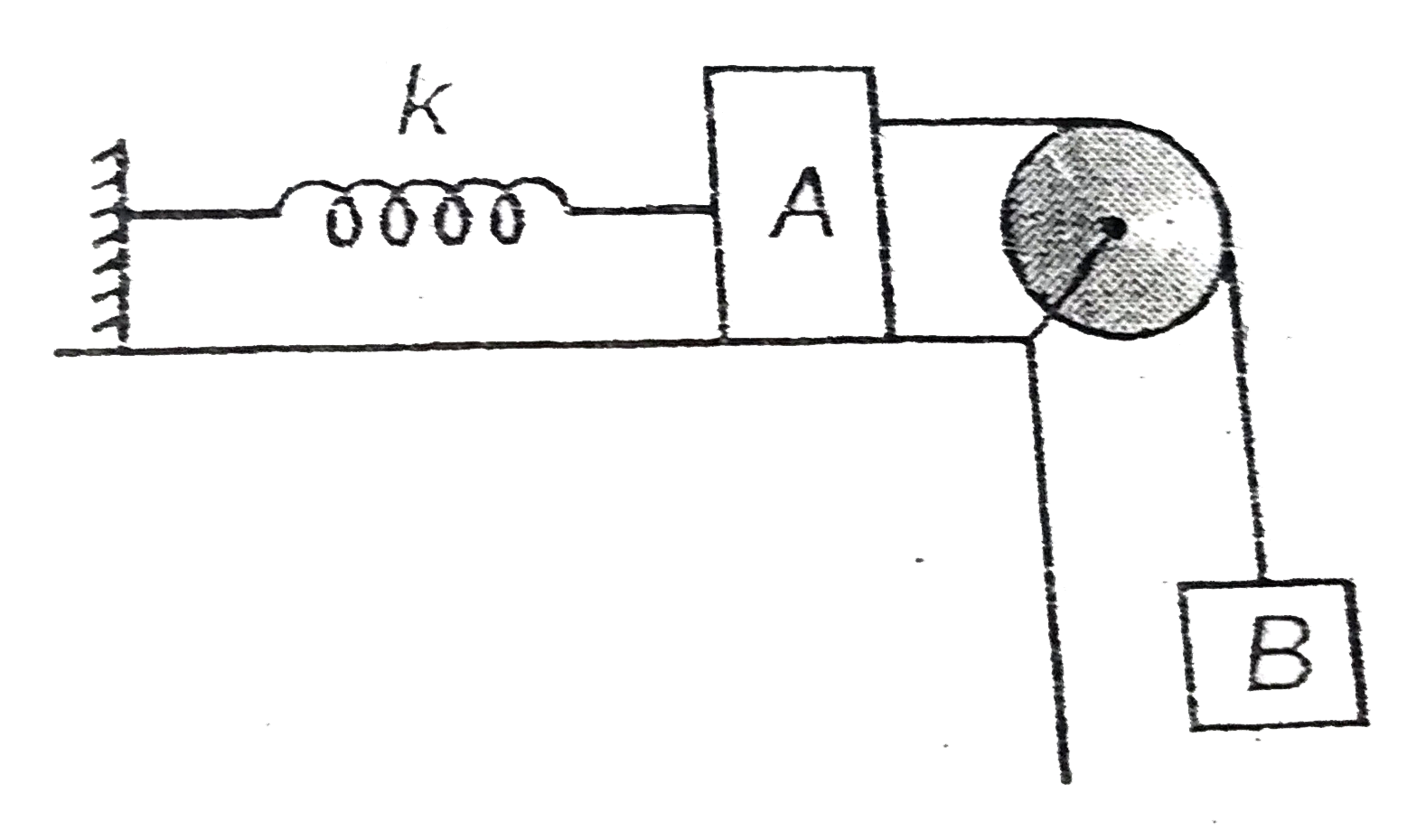In the system shown in fig., mA=4m, mB=3m, and mc=8m. Friction is absent everywhere. String is inextensible and light. If the system is released from rest, then

Acceleration of Block B is
The correct Answer is:Vertical acceleration of A=a=6.25ms−2 (downwards) ; Horizontal acceleration of A=c=1.25ms−2 (rightward) ; Acceleration of B=(a−c)=5.00ms−2(≤ftward) ; Acceleration of C=c=1.25ms−2 (rightward).
Let verically downward component of acceleration of A be a and let acceleration of C be c (rightward).
Then horizontal component of acceleration of A is c (rightward) and acceleration of B, relative to C is a (leftward). Hence, resultant acceleration of B is ,(a−c) leftward.
Now considering free body diagrams.

For block A,
H=2c ...(i)
2g−T=2a ..(ii)
For horizontal forces on block B,
T=1.5(a−c)...(iii)
For horizontal force on block C,
T−H=4C ..(iv)
From above equations,
A=6.25ms−2andc=1.25ms−2
Vertical acceleration of A=a=6.25ms−2 (downwards)
Horizontal acceleration of A=c=1.25ms−2 (rightward)
Acceleration of B=(a−c)=5.00ms−2(leftward)
Acceleration of C=c=1.25ms−2 (rightward).
Topper's Solved these Questions
- NEWTON'S LAWS OF MOTION 1BOOK - CENGAGE PHYSICS ENGLISHCHAPTER - NEWTON'S LAWS OF MOTION 1EXERCISE - Single Correct
75 Videos
- NEWTON'S LAWS OF MOTION 1BOOK - CENGAGE PHYSICS ENGLISHCHAPTER - NEWTON'S LAWS OF MOTION 1EXERCISE - Multiple Correct
11 Videos
- NEWTON'S LAWS OF MOTION 1BOOK - CENGAGE PHYSICS ENGLISHCHAPTER - NEWTON'S LAWS OF MOTION 1EXERCISE - Exercise 6.4
13 Videos
- MISCELLANEOUS VOLUME 2BOOK - CENGAGE PHYSICS ENGLISHCHAPTER - MISCELLANEOUS VOLUME 2EXERCISE - INTEGER_TYPE
10 Videos
- NEWTON'S LAWS OF MOTION 2BOOK - CENGAGE PHYSICS ENGLISHCHAPTER - NEWTON'S LAWS OF MOTION 2EXERCISE - Integer type
1 Videos
Similar Questions

In the arrangement shown in the figure mAmB=23 and the ratio of density of block B and the liquid is 2:1 The system is released from rest. Then
View SolutionIn the system shown in fig. m1>m2 . The system is held at rest by thread BC. Now thread BC is burnt. Answer the following:

Just after burning the thread, what is the acceleration of m2?
View SolutionIn the system shown in figure all surfaces are smooth. Strings is massless and inextensible.Find acceleration of the system and tension T in the string (g=10m/s2)

View SolutionA block of mass m can slide freely in a slot made in a bigger of mass M as shown in fig. There is no friction anywhere in the system.

The block m is connected to one end of a string whose other end is fixed at point P. system is released from rest when the string at P makes an angle θ with horizontal. Find the acceleration of m and M after release.
View SolutionIn the diagram shown, the block A and B are of the same mass M and the mass of the block C is (M1). Friction is present only under the block A. the whole system is suddenly released from the state of rest. The minimum coefficient of friction on block A to keep it in the state of rest is equal to .

View SolutionConsider the situation shown in figure.

Mass of block A is m and that of blcok B is 2m. The force constant of string is k. Friction is absent everywhere. System is released from rest with the spring unstretched. Find
(a) The maximum extension of the spring xm
(b) The speed of block A when the extension in the springt is x=xm2
(c ) The net acceleration of block B when extension in the spring is x=xm4.
View SolutionIn the arrangement shown in Figure, mA=2kg and mB=1kg. String is light and inextensible. Find the acceleration of centre of mass of both the blocks. Neglect friction everywhere.

View SolutionIn the arrangement shown in Figure, mA=2kg and mB=1kg. String is light and inextensible. Find the acceleration of centre of mass of both the blocks. Neglect friction everywhere.

View SolutionBlock A of mass m and block B of mass 2m are placed on a fixed triangular wedge by means of a light and inextensible string and a frictionless pulley as shown in fig . The wedge is inclined at 45∘ to the horizontal on both sides . The coefficient of friction between the block Aand the wedge is 2/3 and that between the block B and the wedge is 1/3 .If the system of AandB is released from rest then find .
a. the acceleration of A
b. tension in the string
c.the magnitude and direction of the frictional force acting on A
View SolutionFor the system shown in fog. m1>m2>m3>m4. Initially, the system is at rest in equilibrium condition., if the string joining m4 and ground is cut, then just after the string is cut.

Statement I: m1,m2,m3 remain stationary.
Statement II: The value of acceleration of all the four blocks can be determined.
Statement III: Only m4 remain stationary.
Statement IV: Only m4 accelerates.
View Solution
